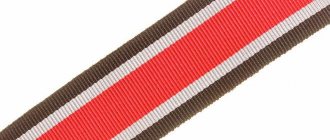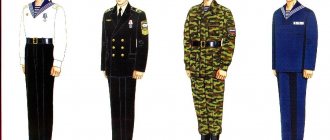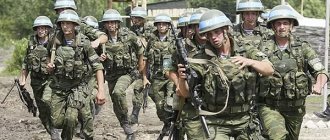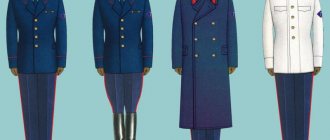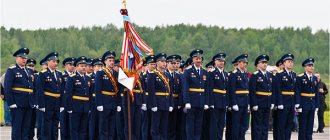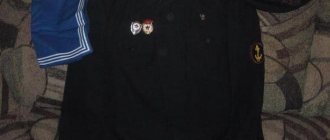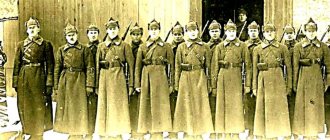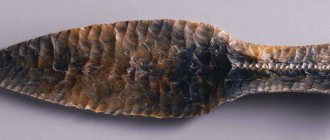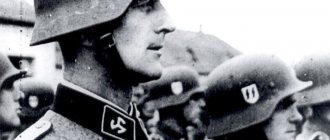Those who served in the army, navy, air force, and the Ministry of Internal Affairs, regardless of age, often recall with warm irony the demobilization uniforms in which they returned home.
The phenomenon of non-statutory modifications to military clothing is indeed widespread in the Armed Forces. This unwritten custom of soldiers and sergeants - to carefully prepare for transfer to the reserve (meaning a uniform embellished to the best of one's personal imagination and an album with photographs) - has been observed for many decades.
New form of airborne forces in Russia
Now let’s travel through 2014 together with Russian Defense Minister Sergei Shoigu.
Not long ago he visited a legendary motorized rifle brigade, known since the Chechen war. In 2014, the soldiers of this unit were transferred to Ugra, and the new uniform acquired a new modern look, so now the military in such uniforms are not afraid of any frost. The new clothes were tested in extremely low temperatures, piercing and cold winds. Sergei Shoigu paid a visit to present awards, the action took place in an open area, and the military had to march in front of the highest leadership of Russia. At first, the form was delivered as an experimental one, but at the end of 2014 it was approved in 9 versions.
The new form for 2014 can be combined in different ways:
- for cool weather it will be enough to wear a lined jacket,
- for windy conditions it is recommended to wear a jacket under the jacket,
- in rainy weather, airborne special forces can wear a fleece shirt with a waterproof overall.
During the active training phase or the airborne assault march, the Airborne Forces wear their usual uniform. During theoretical classes, fighters wear lighter office attire.
The uniform of the Russian Airborne Forces in 2014 went through a number of changes: the ears on the earflap hat became longer, easily overlap at the back and are fastened with Velcro, this is quite important and comfortable for the chin. The hat has a top flap that can, if necessary, turn into a sun visor
Outerwear has also undergone many changes, for example, a jacket can be disassembled into several elements. It has become a kind of construction set that can be transformed from an ordinary windbreaker to a warm pea coat.
The entire 2014 field uniform consists of 16 pieces that easily fit into a backpack.
Depending on the time of year, the backpack can be light or heavy. In the new field footwear, felt boots were replaced by warm boots with inserts. A winter paratrooper vest has also been added, which does not restrict movement. A warm scarf and a comfortable balaclava were added to the whole set. Reconnaissance overalls are made of waterproof material.
Problems with form preparation
Preparing demobilization forms is, in principle, not difficult. It is much more difficult to preserve them and protect them from hazing and the ensign. To do this, soldiers hide their crafts in the kapterka (company storeroom). When officers discover items not provided for by the charter, they are required to confiscate them. The demobilization uniform also falls into the risk category. Checks of soldiers' personal belongings can also take place out of turn, without warning, so it is better not to risk it, but to store the uniform in another place. Of course, many officers may leave the item, because they were once soldiers and were preparing for dismissal. But there are people in the army who strictly follow all regulations. Or, for educational purposes, grandfathers may simply ruin the decoration they started.
What do modern paratroopers wear?
The shape of the new airborne forces is based on the principle of multi-layering. Depending on weather conditions, military personnel are allowed to combine clothing:
- the modern uniform of the Russian Airborne Forces includes several combinations and sets of diverse clothing;
- in the cool season, soldiers are provided with an additional lined jacket;
- often military personnel from the special forces of the Airborne Forces are allowed to wear a jacket under their jacket;
- in rainy, damp weather, the uniform consists of an underwear fleece shirt and overalls with waterproof impregnation.
Thus, what uniform the airborne soldiers will have in a particular case is decided independently by the unit commander, taking into account weather conditions.
Additionally, the hat is equipped with a top flap, allowing it to turn inside out and transform into a visor. Felt boots were replaced with warm boots with thermal inserts. The outer jacket is a designer one and can easily be transformed from a windbreaker into a warm peacoat.
The new uniform set of the Russian Airborne Forces uniform for soldiers and field officers includes 19 items:
- several jackets;
- insulated vest;
- costume;
- three types of boots (summer, demi-season and winter);
- balaclava;
- mittens and gloves.
The summer uniform of the airborne special forces includes:
- underwear (T-shirt and boxer shorts);
- light jacket;
- trousers;
- cap (beret);
- summer boots.
To sew a lightweight version of the airborne uniform, a mechanical stretch treated with a water-repellent compound is used.
Winter uniform for the Airborne Forces option includes:
- two sets of insulated underwear (lightweight and fleece);
- demi-season suit;
- windproof suit;
- insulated vest;
- boots;
- balaclava.
In winter, it is allowed to wear a blue sweater under a jacket that is part of the uniform.
For hot climates, a separate set of uniforms for airborne troops was developed. The new uniform of airborne troops has a light brown or sandy color.
The first option consists of a short-sleeved shirt with a turn-down collar, shoulder straps, trousers and boots in a basic color. The headgear used is a soft cap similar to a baseball cap with a hard visor and a field cockade.
Shorts are allowed instead of trousers. Insignia on this type of uniform are placed similarly to everyday uniforms. This clothing option does not include award stripes. The second option consists of an elongated jacket with shoulder straps, trousers tucked into ankle boots. On the head is a cap or Panama hat that matches the statutory uniform.
The field uniform of an officer is exactly the same as that of the enlisted personnel of the Airborne Forces, only the dress clothes are different.
The ceremonial set of the Airborne Forces uniform consists of a blue jacket and trousers, a vest, a blue beret, aiguillette, white gloves and ankle boots.
Officer ceremonial uniform:
- blue jacket;
- untucked blue trousers;
- shirt;
- black tie;
- White gloves;
- black boots;
- gold aiguillette;
- blue cap with cockade.
The winter dress uniform of midshipmen and airborne officers includes a black jacket, a woolen cap or blue beret, a vest and combat boots. For enlisted personnel and cadets:
- gray hats with earflaps;
- demi-season blue jacket;
- costume;
- vest;
- beret.
Airborne special forces take part in the parade in field uniform. Not only shoulder straps, but also breast and sleeve stripes and chevrons are used as insignia. Before the collapse of the Soviet Union, the uniform was identical for all Airborne Forces employees, regardless of the republic.
Today, each country that was part of the USSR has its own version of the uniform. In the Russian Federation, the main ceremonial color of the Airborne Forces uniform is blue.
For example, not so long ago, the uniform of the highly mobile Ukrainian Airborne Forces was completely changed, in particular, the blue beret was removed from the military personnel’s clothing, replacing it with a similar purple-colored headdress. The main reason for this transformation is that in Russia the blue beret is an integral part of the Airborne Forces uniform.
In turn, in the Republic of Belarus the uniform of the special forces of the airborne special forces still includes a blue beret, as in Russia.
Additions from 1964
Since August 1964, some changes have been made to the infantryman's dress uniform. Black cloth trousers were worn at graduation, and chrome boots were issued instead of shoes. For just one year, changes affected the appearance of the shoulder straps. The red edgings provided for officers were abolished already in 1965.
For MP troops performing missions in areas with high-temperature (hot, humid) climates, a special version of the uniform is provided. It is represented by a beige Panama hat and a short-sleeve shirt. The material for the shoulder straps is the same as for the shirt. Trousers were worn for graduation, and sandals were used as shoes. Soldiers and sailors were required to wear a blue jacket and shorts. The specificity of the style was that the sleeve of the jacket was short, like the sleeve of the shirt.
Since 1967, a red pennant has been placed on the beret. It is still considered one of the symbols of the Marine Corps. For soldiers who took part in the Victory Parade in Moscow, the pennant was located on both sides. When the box passed through Red Square, the mausoleum with stands was on the right, so the pennant was duplicated.
It should be noted here that such orders concerned the dress uniform and were agreed upon personally with the Minister of Defense. Such an innovation was not documented. The same applies to the “guys” collar, which is also used to decorate the modern demobilization uniform.
In 1969, the cockade on the beret changed. It is now oval shaped. The picture is presented with a golden border, inside of which there is a red star on a black background. This sign was assigned only to the cockade for berets. There were no analogues in other branches of the military.
Clothing, defined as everyday clothing and intended for marches or field trips, did not differ in appearance among all ranks, but the material was different. Officers were entitled to a shirt and trousers made of polystyrene, and sailors from cotton wool. Sailors wore the PSh only during routine checks of the highest level. Armrests can be seen on the shirts, and knee pads on the trousers.
At the November 1972 parade, MP troops were represented by soldiers in black suits with white aiguillettes. Now every demobilization officer considers it his duty to decorate his uniform with this element, although it never became statutory.
Summer option
The ceremonial version of the uniform of military personnel of the Russian Aerospace Forces, for cadets and enlisted personnel, of the summer type is a suit. It can be blue or khaki. Under his tunic, a private is required to wear a shirt of the same color, complemented by a tie with a gold tack. Officers are expected to wear a jacket and trousers of the same colors in combination with a white shirt and black tie. The cap of a VKS serviceman must be matched to the color of the suit. The set should include a gold belt.
The field version of the uniform for privates and cadets of the VKS, abbreviated as VKPO, is no different from the uniform version for the ground forces. The kit should include the following clothing items:
- short sleeve underwear;
- jacket with trousers;
- summer boots;
- cap;
- nude summer T-shirt.
Find out: What military ranks were there in the USSR army, what shoulder straps did the soldiers wear?
The office uniform for military personnel of the Russian Aerospace Forces differs in color from the uniform of other branches of the military. For military personnel of the military space forces it is blue. Otherwise, in style and details, it is similar to the uniform of other troops. Stripes and shoulder straps are issued in accordance with the serviceman's type of troops and his ranks.
Dembel uniform
The tradition of leaving for demobilization in a special uniform dates back to the times of the Soviet Union. This form was prepared in advance, six months in advance. Now you can order it on certain websites on the Internet. The uniform is decorated with all sorts of additions, such as aiguillettes, insignia, and rivets. There is also a demobilization version of the VKS uniform; it has its own characteristics. Any demobilization is of two types, strict and exclusive. The difference between them is the degree of finishing with various accessories.
Find out: The rank of captain of the Navy, what the first, second and third ranks mean
The demobilization form of the VKS may include the following details:
Since the founding of this type of troops, the uniform of the Airborne Forces was no different from the clothing of the Red Army Air Force or special purpose air battalions. The set of clothes for a USSR intelligence soldier included:
- Leather or blue-gray canvas helmet.
- Moleskin overalls (could be either leather or blue-gray canvas).
- The collar of the overalls was equipped with blue buttonholes, where insignia were sewn.
Already in the forties, the military uniform for aerial reconnaissance was changed to avisent jackets with trousers. The pants had huge patch pockets. The winter clothes of the USSR paratroopers were insulated with sheepskin uniforms: a brown or dark blue fur collar, which was fastened with a zipper.
The military clothing of the forces was divided into 4 groups:
- summer uniform for every day for sergeants and soldiers;
- summer casual clothing for sergeants, airborne cadets, soldiers;
- summer casual clothing of cadets, where buttonholes and shoulder straps indicated the branch of service;
- winter clothing for sergeants, cadets, military builders, where buttonholes, shoulder straps and a badge on the sleeve are according to the branch of service.
In addition, the military uniform in the USSR had to take into account the climatic features of the area where the troops were located. For example, in the Finnish war, a soldier’s winter clothing was supplemented with:
- hats with earflaps,
- padded jackets,
- cotton pants,
- white camouflage robes and hoods.
The rest of the military clothing in the USSR, for example, for rifle units, looked like a simple budenovka and boots. In addition to their canvas helmets, the paratroopers had large goggles for pilots. This attribute was issued due to the fact that they often had to parachute. If you take a close look at the photo or film materials of those times, you can see that even ceremonial clothing could consist of helmets and glasses, and a parachute jumpsuit.
The military uniform of a USSR officer had a cap with a chin strap for parachute jumping; ordinary Red Army soldiers hid their caps in their bosoms. There were no special shoes for jumping, so felt boots often fell off the feet when the parachute opened. Officer's shoes also presupposed the existence of fur boots.
The usual uniform of the Airborne Forces in Russia differed from other troops only in blue buttonholes; officers had gold trim around them. The piping on the buttonholes of political workers, sergeants or privates was black; this was considered a kind of office option. Officers were also distinguished by blue piping on the collar and the upper edge of the cuffs, and side stitched seams on the riding breeches. Caps with blue piping and red stars or dark blue caps with red enamel stars - all this was typical for the leadership of the Airborne Forces.
During the existence of the Soviet Union, the Ukrainian Airborne Forces were no different in their military uniform from the Russian troops; one single template was in effect throughout the entire USSR. After the collapse of the state, Ukraine had to “redraw” not only the meaning of the type of troops itself, but also the form of intelligence. Until recently, the airborne forces of these two countries could only be distinguished by different stripes, which depicted the coats of arms of different countries. Ukraine's uniform depicts a trident on a yellow-blue background.
What's better to wear for demobilization?
In my opinion, the answer is obvious, of course, this is a demobilization uniform. You can leave in civilian clothes, but, firstly, these are things bought in a hurry during the last dismissal, and they are far from the best quality. Everyone knows that you can’t make a living on a conscript soldier’s salary.
Secondly, in civilian life you will still have time to walk around, but to walk around, perhaps for the last time, in full demobilization uniform - this, I tell you, is worth a lot.
Summer demobilization uniform
Summer is a wonderful time of year, and leaving for demobilization in the summer is a pleasure. Here you have a huge selection of different types and options for the uniform in which you will meet your DMB, starting from the usual field uniform and ending with the front or, as many call it, office uniform - it is also known as “office” in common parlance. Which option you prefer is up to you to decide, because this is your demobilization.
Winter demobilization uniform
Winter is a beautiful time of year, needless to say! Many people mistakenly believe that it is stupid to go on demobilization in the winter in uniform. However, tell me, what could be more beautiful than snow on the shoulder straps of a soldier’s greatcoat?! A winter demobilization uniform made from a front or, as it is also called, office uniform looks great in any bad weather!
How much does a ready-made demobilization uniform cost:
- Demobilization uniform of the ground forces - from 3800 rubles
- Naval demobilization uniform - from 6800 rubles
- Front door (office) - from 7300 rubles
To sum up our discussion, we can conclude that it is much easier and cheaper to order a ready-made demobilization uniform and wait for the parcel than to buy God knows what and God knows where, and then also sew at night, fearing that the uniform will not survive to your DMB.
Undoubtedly, the choice is yours, because this is your DMB and you decide what is best to wear for demobilization! Once again I would like to congratulate you on the near completion of your military service, which became a difficult lesson for you. I would like to sincerely wish you good luck in your future endeavors.
Outdated samples of Airborne Forces uniforms
The winter uniform of an Airborne Forces officer used to be equipped with a dark blue double-breasted overcoat, then the color was changed to regular gray and ear flaps. The field clothing of the troops did not differ from other units at the time of the war, so in winter everyone wore white camouflage overalls, and in summer the colors changed to camouflage.
The paratroopers were given special uniforms immediately before the landing; later the uniform was replaced with a regular one, one might say, office uniform, and the special forces clothing was confiscated. As soon as shoulder straps were introduced, the Airborne Forces began wearing aviation insignia. For privates and sergeants, blue shoulder straps with black edging were introduced, and the stripes were brick-red. The dress uniform has always been distinguished by a blue edging, and the caps have a blue band. The same form was characteristic of the Ukrainian Airborne Forces at the time of being part of the USSR and military operations on one side.
Features of the old-style Airborne Forces dress uniform
For special occasions, the air infantry was provided with a ceremonial set of uniforms, presented in summer and winter versions. In 1988, it underwent a number of changes.
Old style summer dress uniform:
- cap with band;
- untucked trousers;
- open uniform;
- White shirt;
- black tie;
- White gloves;
- black low shoes or boots.
The ceremonial set of the summer uniform had a blue (sea) wave color.
The ceremonial winter uniform of an old-style Airborne Forces soldier:
- hat with ear flaps, lieutenant colonels have a hat;
- gray overcoat;
- open uniform;
- untucked blue trousers;
- White shirt;
- black tie;
- white muffler;
- brown gloves;
- black boots.
Since 1967, the beret has become part of the ceremonial set of clothing, replacing the cap.
What is a birch pattern
Camouflage is a mandatory part of the equipment of the military and, in particular, the reconnaissance troops of the Airborne Forces. The range of camouflage suits is wide, which allows you to choose the ideal camouflage for any climatic and weather conditions. Despite this, the leader of camouflage clothing until recently was the birch (official name KZM-P).
Initially, camouflage with a birch tree pattern was developed for border troops; later it was liked by airborne reconnaissance officers.
A camouflage suit with a birch pattern was created in 1957 and was used as part of the summer equipment of border guards and paratroopers. This camouflage ideally hid the fighter in deciduous forests and swampy areas. Due to its special pixel pattern, KZM-P is capable of dispersing the silhouette of a person at short and long distances.
The raster pattern of the birch camouflage suit resembles spots with jagged edges. Large and small patterns create an optical illusion of a melting silhouette. The light and dark colors of the camouflage coat suggest its use during the day and at night.
Although today the birch camouflage is not a statutory uniform, it is still popular, not only among the military, but also among civilians.
The demobilization uniform is strict
Of course, this article would be incomplete without a brief description of how to make a demobilization uniform. However, there is a nuance here. After all, by and large, there are two types of such clothing:
- strict form of demobilization;
- demobilization uniform is exclusive.
Which one is preferable? There is no single answer here. Of course, this is a matter of demobilization taste. However, if the retiree has a sense of style, then we would recommend the first option. It is more restrained; it provides for individual modifications to the standard soldier's uniform, verified in practice over many generations of demobilization.
This is, for example, the classic demobilization form of air defense. We list the improvements to the strict form of demobilization:
- tunic and trousers tailored to fit in the studio (if necessary);
- an additional chevron of the military branch sewn onto the jacket;
- inserts under the shoulder straps of the jacket (the latter retain their flat shape and decorate the contour of the shoulder);
- homemade shoulder straps for a shirt (they are not provided for in the form, but craftsmen make them to their liking);
- modified shape of the “aerodrome” cap (achieved by increasing the ribbon spring inserted into the rim);
- standard military badges of the branch of service, class, sports categories, etc., arranged in the prescribed order.
By the way, according to experts, the naval demobilization uniform looks especially spectacular. Below we will tell you more about it.
The phenomenon of demobilization uniform is a plus for the army
For example, in the 1990s, memorable for the trend of negative attitudes towards the army, demobilized people went home in civilian clothes.
A paradoxical psychological tendency can be traced: if demobilizers use demobilization uniforms for the way home, then this indirectly indicates the prestige of military service.
In other words, a soldier who follows such a tradition actually demonstrates his loyalty to the army, expressing pride in the very fact of his service in a kitschy form accessible to him.
In addition to his uniform, he also takes home his demobilization album, which is both a chronology of his service and a memory of his colleagues.
Distinctive features of the field uniform
Soviet paratroopers had two options for clothing for field conditions: summer and winter. The summer field uniform set included:
- cap;
- jacket and trousers in khaki colors;
- vest;
- boots or high boots.
Description of the winter uniform of the Airborne Forces:
- hats with earflaps;
- khaki jacket and pants;
- gray muffler;
- brown gloves;
- berets or boots.
The entry of Soviet troops into Afghanistan required the leadership to reconsider the equipment of employees. The classic field uniform is being replaced by a lighter version, popularly called Mabuta after the colonel of the Congolese army. It was made of raincoat fabric with water-repellent impregnation, a ventilation system and a more comfortable cut.
The sand uniform consisted of trousers, a jacket and a cap and was used during combat missions in regions with a hot climate.
Innovations in 1984
The highest legislative body of the USSR, with its document of 1984, introduced a new field uniform format, specifically designed for military personnel serving in the MP. It was developed in both winter and summer versions. Camouflage material is used for the first time. The traditional protective form is also not abandoned, and both of these materials are used as a vole. Practice has shown that they did not equip the landing troops with khaki uniforms, so camouflage secretly began to be considered the calling card of a Marine. It was worn strictly as a vest, with a Marine Corps chevron on the left sleeve. The cockade on caps and hats is made in green.
Since 1988, the famous oval cockade that adorned the beret has been replaced by a star in a gilded wreath. From this point on, certain elements could be permitted by internal order from the unit commander. Among them are a black cap with a white cover, a black beret or black jacket, a camouflage cap, an overcoat in summer (in case of cold weather), and a raincoat. Special forces of the amphibious assault use a knife when performing combat missions. It is included in the ammunition of modern equipment.
This is where the history of the USSR Marine uniform ends, along with the era. The Russian army in many ways became the successor to the USSR army. Only the symbolism has changed. In all troops, the cockade on the winter hat was replaced by an oval with a tricolor. It is known that Valentin Yudashkin became a fashion designer for law enforcement agencies. The question of the beauty and practicality of the form must be digested for years. But one thing can be said with confidence - the Marine Corps uniform remains one of the most beautiful in the Russian Armed Forces.
What kind of demobilization uniform do paratroopers have?
The tradition of sewing a demobilization outfit comes from the Soviet Union, when military service was considered honorable. DMB is a kind of confirmation that the soldier served well and is proud of his army uniform. What can we say about the guys who paid their debt to the Motherland in the ranks of the Airborne Forces.
And although in the early 90s they preferred to go into the reserves in civilian clothes, today military personnel have returned to this beautiful custom.
The demobilization uniform of an Airborne Forces soldier is prepared on the basis of a field uniform using several rules:
- the suit should not be pretentious or overly elegant;
- placement of insignia and external chevrons is carried out in accordance with the statutory rules.
For the layout of the suit, an acanthus tunic or “gorka” can be used, which is often chosen by airborne special forces, trousers, a vest and combat boots. A mandatory attribute of the finished outfit is a blue beret.
It is an honor to serve in the airborne forces and many guys would like to be in the ranks of the blue berets. But this honor is not granted to everyone, which does not prevent civilians from trying on the paratrooper uniform.
Today there are not only adult, but also children's airborne uniforms on sale. Why do civilians wear military uniforms at events dedicated to the celebration of victory and other celebrations? Everyone has their own reasons for this. For example, children's military uniforms of the Airborne Forces are popular during the celebration of Victory Day.
On the other hand, as boxer Denis Lebedev explained, this shows respect for the paratroopers. It's hard to disagree with the athlete; they really deserve respect.
About the tradition of returning home in demob uniform
Why did such a tradition become established? It dates back to Soviet times. The reason is clear: soldiers are waiting for the day of transfer to the reserve, dreaming of it as a holiday... It marks a change in their rhythm of life from regulated by service to personal. People who have matured in the Armed Forces dream about the future arrangement of their lives: work, prosperity, finding a soul mate. But first... demobilization must take place.
Obviously, such an event is a kind of milestone in the life of young men preparing for discharge from demobilization. Such clothing is not intended for military everyday life or military holidays. It corresponds only to the mental state of one person - its owner. Her mission is quite fleeting in time: to decorate the return home, to demonstrate to family, friends, and acquaintances that the soldier, having served the Motherland honestly and like a man, is finally with them.
Sometimes its creation is a kind of kitsch, an attempt to stylize an ordinary soldier's uniform to give it extravagance and loudness. Stripes, aiguillettes, badges, and chevrons are used.
Uniform requirements
- At the moment, the uniform of the Russian Airborne Forces involves several sets and combinations of diverse clothing (not only of a combat nature).
- In cool weather conditions, a lined jacket is added for soldiers.
- Often the military resorts to using a sweater under a jacket.
- When the weather is quite humid, damp and rainy, you can wear a fleece undershirt and a waterproof overall.
- During active service, military personnel wear personal uniform. When the conditions for a military man are related to theoretical training, the military can be in mild shape.
It is also worth noting that such a conservative version of clothing is constantly undergoing new and more effective changes. Every time the creators provide an almost perfect uniform. However, time passes, more and more new knowledge is accumulated, equipment and technology are developing.
Depending on personal preferences, as well as weather conditions, the military themselves will select the combination of uniforms they need.
All this, one way or another, has a direct impact on the continued improvement of uniforms for soldiers in general and special units in particular, which are the Airborne Forces. It is no coincidence that last year was marked as another chronological starting point for the new model of the Airborne Forces uniform, with regular changes and innovations...
Today, the uniform of an Airborne Forces soldier has earflaps with long ears, which overlap without problems and are fastened with a special Velcro, which makes it possible to more effectively cope with the protection of the chin. The earflaps have a top flap, with the ability to turn inside out and transform into a visor that protects from the sun.
A sufficient number of changes also affected the outerwear of the Airborne Forces. A modern landing jacket can be roughly disassembled into a couple of parts. Now she has the opportunity to transform into a warm pea coat.
There is also a field uniform for an Airborne Forces soldier, the number of elements of which is already greater, namely, it consists of 16 items of clothing that easily fit in a compact combat backpack. However, you should not focus on weight, since in warm weather the weight of the backpack increases significantly, and in cold weather it decreases, and sharply.
The felt boots have been completely replaced with new insulated boots with thermal inserts. The insulated version of the field uniform today has a vest, which, to the delight of the fighters, in no way restricts movement during moments of physical activity. In addition, we must not forget about a special scarf-front that protects from the wind, as well as a comfortable balaclava. The overalls itself and all its components are made in a waterproof version.
There is also a dress uniform and a demobilization uniform for a soldier who has served his military service in the Airborne Forces. See the photo to see what the ceremonial and demobilization uniforms look like.
There are no exceptions to the rules for female military personnel. The only difference is the presence of a skirt in the formal version.
Air force demobilization uniform
The Air Force demobilization uniform is made on the basis of the field uniform. It can be purchased online by sending your measurements to the manufacturer: height, chest circumference, waist circumference, sleeve length, headdress size. The purchase is made by 100% payment, 50% prepayment and interest-free installments.
The kit of the purchased uniform includes a jacket, “modified” with blue velvet shoulder straps or chevrons attached using semi-rigid relief linings, as well as a blue improved beret.
However, the Air Force demobilization uniform can be made independently. To do this, the serviceman must purchase a set of field uniforms made from digital fabric and modify it. You will need to spend money on purchasing additional chevrons and aiguillettes at the military store. Specific flight badges and insignia should be obtained. Blue velvet is bought in a civilian retail chain.
There is one auxiliary detail for giving the ideal shape to shoulder straps, chevrons, and stripes. It is made by hand from cellophane and white fabric. This is a semi-rigid lining. To make it you need a minimum of materials: cellophane and a piece of old bleached sheet. The tools you will need are a hot iron and scissors.
The technology is simple: two layers of fabric are glued together using cellophane using a hot iron. This is followed by another layer of cellophane, fabric, etc. The product is simple, but the shoulder straps and chevrons sewn with it are not visually lost, they are accentuated and look prominent.
Infantry and its demobilization uniform
Demobilized infantry uniform is an outdated name. Now this branch of the army is called differently - motorized rifle. What are these clothes? Judging by the examples we saw, it is similar to the Air Force uniform described above.
The differences are predictable: instead of blue velvet, black is used, specific insignia for the branch of the military: chevrons, buttonholes, badges of military affiliation, class, etc. Instead of a blue beret, black is used. In general, the cut of the field uniform, vest, aiguillettes, and sewn trousers are identical.
